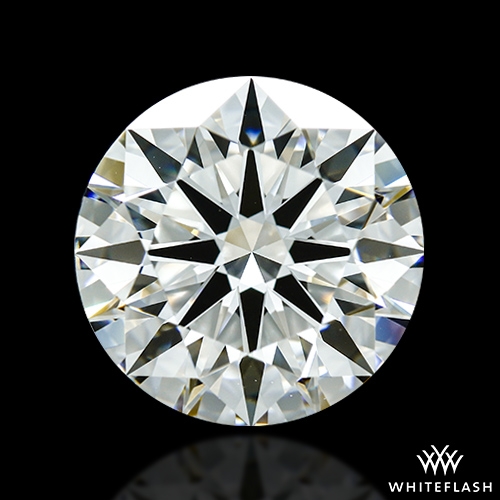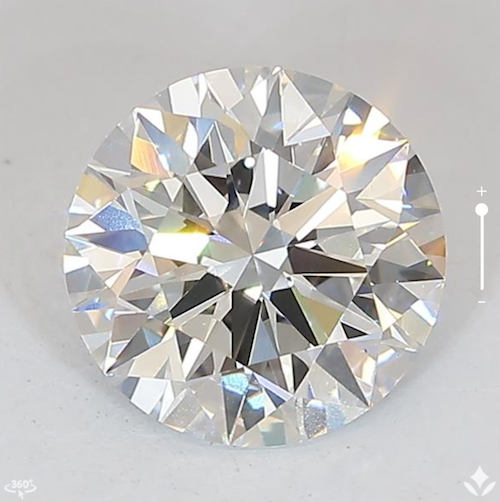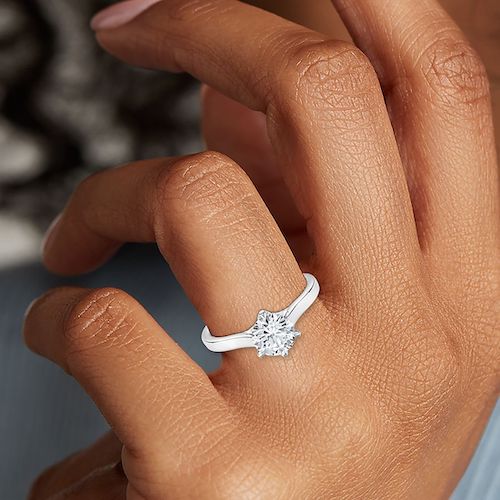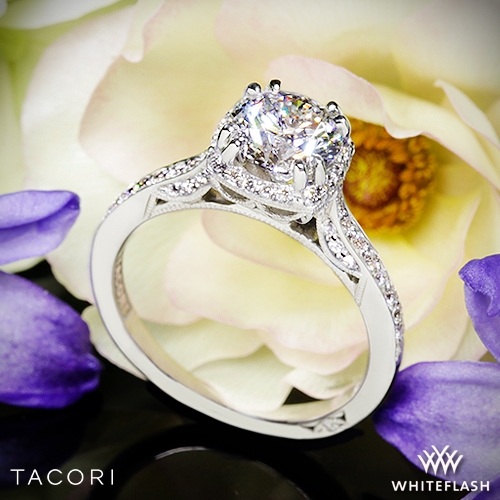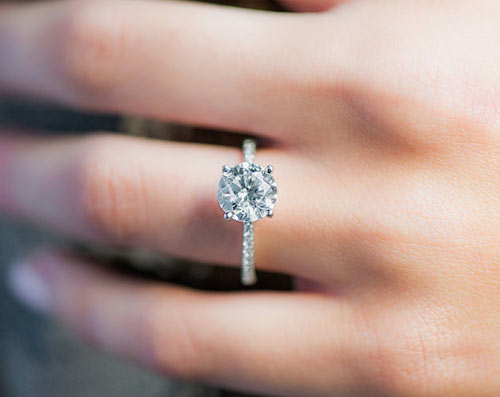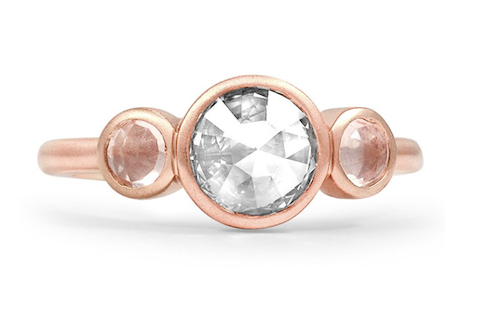Diamond Education
2 Carat Diamond Guide
Diamonds have long been a symbol of luxury, elegance, and commitment. Among the many sizes available, a 2 carat diamond stands out as an especially desirable choice. Boasting a substantial size and impressive sparkle, it's a favorite for engagement rings, pendants, and other jewelry pieces. In this comprehensive guide, we'll explore everything you need to know about two carat diamonds - their size, cost, natural vs. lab-grown varieties, ideal settings, and much more. Plus, we'll share expert tips to help you make the best purchase.
Summary:
- How Big is a 2 Carat Diamond?
- How much does a 2 Carat Diamond Cost?
- Natural 2 Carat Diamonds
- Lab-Grown 2 Carat Diamonds
- 2 Carat Diamond Settings
- Where to Buy the Right 2 Carat Diamond
How Big is a 2 Carat Diamond
Carat refers to the weight of the diamond, not its size. A 2 carat diamond weighs 0.4 grams. However, the size - more specifically, the surface area viewed from the top - can vary based on the diamond's cut. On average, a well-cut 2 carat round diamond will have a diameter of about 8.1mm.

Image Courtesy: Whiteflash
However, keep in mind that the perceived size of the diamond can be influenced by the shape and cut of the diamond. For instance, a 2 carat diamond with a deep cut may appear smaller than one with a shallow cut, as more of the diamond's weight is hidden in the depth. Similarly, elongated shapes like oval or marquise may appear larger than round or princess cuts of the same carat weight.
How Much Does a 2 Carat Diamond Cost?
The price of a 2 carat diamond is determined by a combination of factors. These include the diamond's cut, color, and clarity, along with its carat weight - collectively known as the Four Cs.
The cut of the diamond is arguably the most important factor. A well-cut diamond will reflect light to its fullest potential, creating that much-desired sparkle and brilliance. On the other hand, a poorly cut diamond, even if it is large in size, may appear dull.
Color and clarity also significantly impact a diamond's price. Diamonds are graded on a color scale from D (colorless) to Z (light yellow or brown). The closer to D, the more valuable the diamond. Clarity refers to the absence of inclusions or blemishes. Diamonds with fewer inclusions are more expensive as they are rarer and more aesthetically pleasing.
It's also worth noting that prices jump at whole carat weights, so a 2 carat diamond will cost more than twice a 1 carat diamond, assuming all other factors are equal.
On average, a round 2 carat natural diamond can range from around $8,000 to $75,000. The wide price range accounts for differences in the quality of the cut, color, and clarity.
For those looking for a more affordable alternative, lab-grown diamonds offer a great option. These diamonds are physically, chemically, and optically identical to natural diamonds but are created in a laboratory. A 2 carat round lab-grown diamond typically costs between $1,000 and $6,000.
Natural 2 Carat Diamonds
Natural 2 carat diamonds are just that - diamonds that have formed naturally over billions of years deep within the Earth under extreme heat and pressure. The rarity of these stones, coupled with their enduring appeal and the arduous process of mining, cutting, and polishing them, contribute to their high value.
The journey of a 2 carat natural diamond from the depths of the Earth to a dazzling piece of jewelry is truly remarkable. After they are mined, these rough diamonds are evaluated and sorted based on their potential color, clarity, and carat weight. Expert gemologists then cut and polish the diamonds to maximize their brilliance and fire.
Natural diamonds often have unique inclusions, sometimes referred to as "nature's fingerprints." These tiny imperfections, invisible to the naked eye, make each diamond one-of-a-kind.
When purchasing a natural 2 carat diamond, it's essential to consider its Four Cs - cut, color, clarity, and carat weight. These will determine the diamond's quality and value. Certified diamonds come with a grading report from a trusted gemological lab, which provides an objective analysis of the diamond's characteristics and quality.
Lab-Grown 2 Carat Diamonds
Lab-grown diamonds, also known as man-made or synthetic diamonds, have risen in popularity in recent years. While they share the same physical, chemical, and optical properties as natural diamonds, their origin and pricing set them apart.
A lab-grown 2 carat diamond is created in a laboratory environment using high-pressure, high-temperature (HPHT) or chemical vapor deposition (CVD) methods. These processes replicate the natural formation of diamonds, producing stones that are virtually identical to natural diamonds in terms of their appearance and hardness.
One of the key advantages of lab-grown diamonds is their cost-effectiveness. Because the process of creating diamonds in a lab is more controlled and less resource-intensive than mining, lab-grown diamonds often cost significantly less than natural diamonds of similar size and quality. This price difference means that buyers can potentially opt for a larger stone or higher quality grades within the same budget.
For example, a 2 carat lab-grown diamond can range from around $1,000 to $6,000, depending on factors such as cut, color, and clarity. This is significantly less than the price range for a natural 2 carat diamond, making it an attractive option for budget-conscious buyers or those wanting to maximize the size or quality of the diamond for their budget.
2 Carat Diamond Settings
Selecting a setting for your 2 carat diamond significantly impacts the overall appearance and style of your jewelry. Here are some popular settings:
Solitaire Setting
The solitaire setting, featuring a single diamond on a band, is a classic choice. This design allows the 2 carat diamond to be the focal point. The number of prongs used can vary. For a 2 carat diamond, a six-prong setting is often recommended for added security, although four prongs can also be used for a less obstructed view of the diamond.
Halo Setting
The halo setting surrounds the center diamond with smaller diamonds, enhancing the perceived size and sparkle of the 2 carat diamond. Multiple prongs hold the central diamond securely.
Pavé Setting
A Pavé setting features a band lined with small diamonds, creating a continuous sparkle to complement the center diamond. The 2 carat diamond is typically secured with four or six prongs.
Bezel Setting
The bezel setting offers a sleek modern look, with a thin metal band encircling the diamond. It's a great choice for those seeking extra protection for their diamond, as it surrounds the diamond's edge.
When choosing a setting, consider the diamond's security, the wearer's lifestyle, and personal style. More active individuals or those who work with their hands may benefit from more secure settings like a six-prong solitaire or a bezel.
Where to Buy the Right Two Carat Diamond
Choosing where to buy your 2-carat diamond is as important as choosing the diamond itself. Here are several reputable online diamond retailers, each offering unique advantages:
Whiteflash
Whiteflash is often considered the best of the best when it comes to diamond quality. They offer an extensive collection of both natural and lab-grown diamonds. Known for their high-quality cut diamonds, they also offer a wide array of designer settings. Their exceptional customer service includes providing comprehensive diamond education and guidance to buyers. They offer light performance images and high-definition videos of their diamonds, allowing you to see your potential purchase in great detail.
Brilliant Earth
Brilliant Earth were pioneers in the lab-grown diamond industry, and they offer a wide selection of these along with natural diamonds. They also provide HD imagery and 360-degree views of their diamonds, helping buyers make informed decisions.
Blue Nile and James Allen
Blue Nile and James Allen are two more excellent options, especially for buyers seeking quality at a lower price point. While the quality may not be as high as Whiteflash, both offer a broad selection of diamonds and settings. They provide 360-degree HD videos of their diamonds, and even provide some light-performance imagery.
Tools like light performance images and HD videos can help you understand a diamond's true appearance and sparkle. They can be particularly helpful when shopping online, where you can't see the diamond in person.

